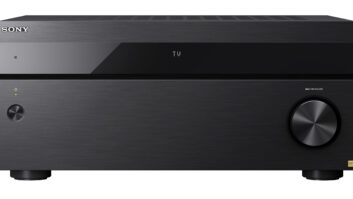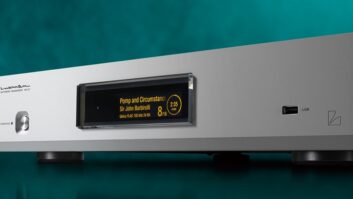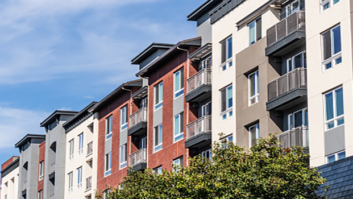A Litany of Acronyms Reveal How Sound Transmission is Measured, or Not

Courtesy of professional acoustician, John Storyk, these diagrams illustrate a specific type of partition next to its corresponding STC rating.
In the dichotomy of audio and video, sound is by far the more subjective of the two. It does have a robust measurement scheme in the decibel (dB) scale, but its use across a wide variety of applications can make even the logarithmically precise dB a fuzzy witness. One example is the range of scales used to measure the transmission of sound between spaces separated by a partition–walls, windows, doors, and floors.
There are several methods of measuring sound through partitions, but the most commonly used one, at least in North America, is STC, or Sound Transmission Class. (Europe and elsewhere use the Sound Reduction Index (SRI) ISO-based index.) STC is a measure of sound isolation, as expressed in transmission loss (TL). The STC number is derived from sound attenuation values tested at 16 standard frequency bands from 125 Hz to 4 kHz. These transmission-loss values are then plotted on a sound pressure level (SPL) curve using a complex algorithm, thus giving us one number that summarizes the 16 individual measurements. A standard curve is fitted to the measured transmission loss curve, so the sum of the deficiencies in the 16 one-third-octave bands is no greater than 32 dB, and no single deficiency exceeds 8 dB. Based on those correlations, the STC is the value given by the standard curve’s position at 500 Hz.
It’s a complicated, but reasonably elegant solution. Yet it’s also filled with some significant flaws. For instance, the ability of any partition material to reduce sound transmission will vary according to frequencies. If an 80 dB sound on one side of a partition is reduced by that partition to 50 dB on the other side, then that partition is said to have an STC of 30. But any partition will have less transmission loss at lower frequencies. For example, a wall with an STC value of 30 may provide over 40 dB of attenuation at 3 kHz but only 10 dB of attenuation at 125 Hz.
“It really depends on what you’re trying to isolate,” explained Eric Pollard, owner of the Sound Isolation Store, an online sales portal and distribution center for sound attenuation products, based in the Boise area. “If you’re dealing with an office or a classroom, then you’re mostly in the spoken-word frequency range, and STC is a useful way to measure sound isolation. But once you get into the 63 to 80 HZ range, where home theaters take you, an STC rating is a lot less relevant.”
The first, and most severe, problem with the STC system is that it only considers frequencies down to 125 Hz, said Pollard, who explained that most of the sonic energy generated by the average home theater or recording studio occurs there, as does a large percentage of the sonic energy generated by traffic, airplanes, music, and machinery noise.
“If you have sound isolation problems, there is a very good chance that it is low-frequency noise you are having trouble with, so one could say that the STC calculation completely ignores the frequencies that are most problematic,” he continued. “It assumes even energy dispersion. It is accurate within its frequency range only for noise sources that have approximately even energy levels across the frequency band. Most noise sources do not meet this criterion and some, like sound generated from movies and music, are worlds away from this criterion.”
These shortcomings are, in large part, a function of the STC calculation’s age, which dates back to 1961, a time before computers made complex calculations easy, and an age when low-frequency energy wasn’t nearly as ubiquitous or as loud.
Another failing of the STC rating, Pollard contended, is that it’s often arrived at via questionable means. And many products that were initially tested decades ago continue to display the STC ratings they earned at the time, even when they are applied to iterations of a product that are several generations down the line.
“I wouldn’t consider an STC rating made before 2000 as accurate,” Pollard stated. “The testing equipment used in 1979 is nowhere near as sophisticated as we have now. Plus, many ‘ratings’ have fine print that says they’re accurate ‘plus or minus 6 dB.’ You need to look at these ratings with a skeptical eye.”
Other Acoustical Acronyms
There are other sound isolation measurement protocols. Most are listed by ASTM International– the American Society for Testing and Materials, which develops voluntary consensus standards for sound measurement, among other things. Its ASTM E413 – 10 Classification for Rating Sound Insulation category lists test methods including STC, NIC, and a single-number rating for ceiling attenuation class (CAC). Another ASTM scale (ASTM E-1332) is the Outdoor-Indoor Transmission Class (OITC), a standard used for indicating the rate of sound transmission between outdoor and indoor spaces in a structure. It is based on the ASTM E-1332 Standard Classification for the Determination of Outdoor-Indoor Transmission Class. OITC utilizes a source-noise spectrum that considers frequencies down to 80 Hz and is weighted more to lower frequencies. The Impact Insulation Class (IIC) rates how well a building floor attenuates impact or transient sounds, such as footsteps. The IIC number is derived from sound attenuation values tested at sixteen standard frequencies from 100 to 3,150 Hz. These types of noise, however, are also generated at frequencies below 100 Hz, so the IIC value has limitations similar to those of STC.
Noise criteria (NC) measures noise, per se, rather than quantifying its transfer, but it’s also a useful value. Like STC, it measures sound along a set of criteria curves, though these are more comprehensive than STC’s, extending from 63 to 8 kHz. The NC rating is determined by plotting the third-octave band levels for a given noise spectrum, aka the NC curves. The noise spectrum is specified as having a NC rating that is the same as the lowest NC curve that is not exceeded by the spectrum.
STC: The Good, The Bad
STC results can be misleading. For instance, in the case of two similar partitions, if one allows more frequencies below 125 Hz to pass than the other, it can end up with a substantially higher STC rating, simply because what it does allow to transfer is outside the scope of the STC’s standard measurement range. Even a very slight shift down in frequency can yield a significant gain in STC points. Over the decades, more than one manufacturer has leveraged this discrepancy to their advantage.
And who can blame them? As flawed as it may be, STC remains pretty much the de facto industry standard. “It’s the only number that everyone recognizes,” said Jeremy Stinson, president of Architectural Traditions, the regional distributor for German Unilux, whose glass windows and doors are widely used in recording studios and home theaters. “It’s the only way to compare apples to apples. It’s at least a gauge of at least one aspect of a window’s performance characteristics,” along with other measures, such as heat loss and solar values.
Pollard said flatly that it’s simply easier for companies marketing commercial products to achieve a significant increase in STC values than it is to attain a similarly large increase when measuring across the full frequency range. He does believe that custom integrators have become more aware of the need to take transmission loss into account for their audio systems designs, and that they’re reasonably aware of STC’s limitations. But he also said that misunderstandings about the nature of STC persist, such as the fact that the ratings are not cumulative when various materials are combined.
“You might have mass-loaded vinyl with an STC rating of 26 and a wall that’s rated for 35 but they do not equal a total of STC 61,” he explained. “Together they might average out closer to an STC 43 or 44.”
John Storyk, a principal at Walters-Storyk Design Group, who is noted for his work with recording studios but often works on high-end home theaters and other monitoring environments, said that, for him, STC is at best one reference datum among many, and not even a particularly good one. However, he pointed out, in the process of measuring for sound transmission, manufacturers of products like doors and windows do collect data that includes low-frequency performance information. It’s just that they don’t include that in the STC evaluation because nothing below 125 Hz is part of that protocol.
“That information is there, and it should be available if you ask for it,” Storyk said. “We tend to avoid products from manufacturers that won’t provide us with that information.”
STC is a mixed blessing. One the one hand, at least everyone is measuring according to a clearly delineated standard within a fixed frequency range; on the other hand, though, there is potentially wide variation in measurement environments and STC’s inherent low-frequency exclusions. As Pollard sums it up, “It’s not great, but it’s the best we have.”
Dan Daley is a freelance writer based in Nashville, TN.






